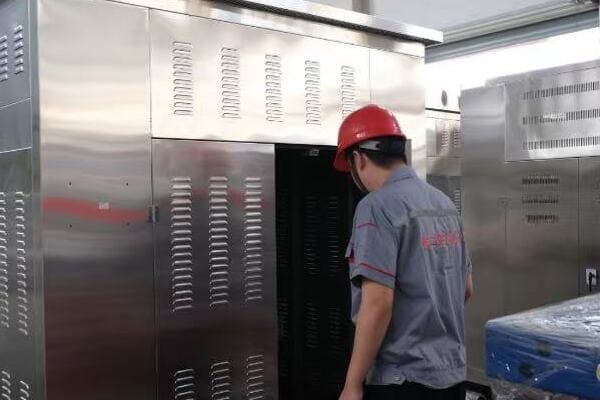China vs USA: 5 Key Differences in Distribution Transformer Markets?
Are you struggling to navigate the complex differences between the Chinese and American distribution transformer markets? You’re not alone. Many manufacturers and buyers find themselves confused when dealing with these two distinct ecosystems. But what if you could easily understand the key differences to make informed decisions for your projects or export strategies?
China and the USA differ significantly in their distribution transformer markets. From grid regulations and procurement models to supplier structures and energy demands, understanding these 5 key differences can help manufacturers, buyers, and engineers make smarter project and export decisions.

In this comprehensive guide, I’ll walk you through the five crucial differences between the Chinese and American distribution transformer markets. Whether you’re a manufacturer looking to export, a buyer sourcing transformers, or an engineer working on international projects, this article will provide you with valuable insights to navigate these distinct markets effectively.
Regulatory Standards: IEC vs ANSI?
Are you finding it challenging to understand the impact of different regulatory standards on transformer design and manufacturing? The divergence between IEC and ANSI standards in China and the USA respectively can significantly affect your approach to transformer projects. But how do these standards differ, and what does it mean for your business?
China primarily follows IEC standards (e.g., IEC 60076), while the USA adheres to ANSI standards (e.g., ANSI C57). This difference affects transformer design, testing procedures, and certification requirements. IEC standards are more globally adopted, while ANSI standards are specific to North America. Understanding these differences is crucial for manufacturers exporting between these markets and for engineers working on international projects.
Diving Deeper into IEC vs ANSI Standards
Let’s explore the key differences between these regulatory frameworks:
- Design and Construction Requirements
- Testing Procedures
- Efficiency Standards
- Safety and Environmental Considerations
- Impact on Export and International Projects
Design and Construction Requirements
IEC and ANSI standards have different approaches to transformer design:
- IEC focuses on performance-based requirements
- ANSI tends to be more prescriptive in design specifications
I once worked on a project exporting transformers from China to the USA. We had to completely redesign our IEC-compliant transformers to meet ANSI specifications, particularly in areas like bushing design and tank construction.
Testing Procedures
Testing methods and requirements differ significantly:
- IEC emphasizes type tests for design validation
- ANSI requires more extensive routine tests for each unit
During a recent factory acceptance test for a US client, we had to implement additional short-circuit and impulse tests that weren’t typically required for our IEC-standard transformers. This added time and cost to the manufacturing process.
Efficiency Standards
Energy efficiency regulations vary:
- China follows IEC 60076-20 for efficiency classes
- USA adheres to DOE efficiency standards
Here’s a quick comparison of efficiency requirements:
| Aspect | IEC (China) | ANSI (USA) |
|---|---|---|
| Efficiency Tiers | Multiple classes (e.g., 1, 2, 3) | Single minimum standard |
| Load Point for Rating | 50% load typical | 35% load for distribution transformers |
| No-Load Loss Emphasis | Higher emphasis | Balanced approach |
Safety and Environmental Considerations
Both standards prioritize safety, but with different focuses:
- IEC has more detailed requirements for environmental protection
- ANSI places higher emphasis on fire safety and seismic requirements
In a recent project for a US data center, we had to significantly modify our standard Chinese design to meet the stringent fire safety requirements of ANSI standards, including the use of less flammable insulating fluids.
Impact on Export and International Projects
Understanding these differences is crucial for international business:
- Manufacturers need to adapt designs for different markets
- Certification processes differ, affecting time-to-market
- Cost implications for design modifications and testing
Key considerations when dealing with IEC vs ANSI standards:
- Design flexibility to meet both standards if targeting both markets
- Investment in testing equipment and procedures to comply with both
- Understanding of certification processes in both regulatory environments
- Awareness of the cost implications of meeting dual standards
- Training for engineering teams on both standard systems
In my experience, successfully navigating these different standards requires a strategic approach. I’ve seen companies struggle when they try to force IEC-designed transformers into the US market without proper adaptation. Conversely, those who invest in understanding and meeting both standards often find they can compete more effectively in global markets.
As we move forward to discuss other differences between the Chinese and American markets, keep in mind how these regulatory standards form the foundation for many of the other distinctions we’ll explore. Understanding these standards is not just about compliance; it’s about opening doors to new market opportunities and ensuring your products can compete on a global stage.
Grid Infrastructure and Voltage Levels?
Are you aware of how significantly the grid infrastructure and voltage levels differ between China and the USA? These differences can greatly impact transformer design and application. But what exactly are these differences, and how do they affect your approach to transformer projects in these markets?
China and the USA have distinct grid infrastructures and voltage levels. China typically uses 10kV/400V for distribution, while the USA often employs 13.8kV/480V. These differences affect transformer design, capacity planning, and application scenarios. Understanding these variations is crucial for manufacturers, engineers, and buyers working across these markets to ensure compatibility and optimal performance.
Analyzing Grid Infrastructure and Voltage Levels
Let’s explore the key differences in grid infrastructure and voltage levels:
- Distribution Voltage Standards
- Transformer Capacity and Design Implications
- Grid Topology and Connection Methods
- Impact on Renewable Energy Integration
- Future Trends and Smart Grid Considerations
Distribution Voltage Standards
China and the USA have different standard voltage levels:
- China: Typically 10kV for medium voltage, 400V for low voltage
- USA: Often 13.8kV for medium voltage, 480V for low voltage
I recall a project where we were adapting Chinese-made transformers for a US industrial park. The difference in standard voltages meant we had to completely recalculate and redesign the transformer windings to ensure proper voltage ratios and tapping ranges.
Transformer Capacity and Design Implications
These voltage differences affect transformer design:
- Chinese transformers often designed for higher current at lower voltage
- US transformers typically handle lower current at higher voltage
Here’s a comparison of typical distribution transformer specifications:
| Aspect | China | USA |
|---|---|---|
| Common MV/LV Ratio | 10kV/400V | 13.8kV/480V |
| Typical Capacity Range | 30 – 1600 kVA | 45 – 2500 kVA |
| Standard Frequency | 50 Hz | 60 Hz |
| Typical Vector Group | Dyn11 | Δ-Y |
Grid Topology and Connection Methods
Grid structure and connection methods vary:
- China: More centralized grid structure, often with radial distribution
- USA: More decentralized, with greater use of loop systems
During a recent consulting project for a Chinese manufacturer entering the US market, we had to redesign their transformer protection systems to account for the more common loop feed systems in US urban areas.
Impact on Renewable Energy Integration
Renewable energy integration differs due to grid structures:
- China: Large-scale, centralized renewable projects common
- USA: More distributed generation, including residential solar
In a solar farm project in the USA, we had to adapt our transformer designs to handle more bi-directional power flow, which is less common in the more centralized Chinese grid system.
Future Trends and Smart Grid Considerations
Both countries are moving towards smart grids, but with different approaches:
- China: Rapid, large-scale smart grid deployments
- USA: More gradual, often utility-driven smart grid adoption
Key considerations for dealing with grid infrastructure differences:
- Understand voltage standards and their impact on transformer design
- Consider frequency differences (50 Hz vs 60 Hz) in core design
- Adapt protection and control systems for different grid topologies
- Design for different power quality requirements in each market
- Stay informed about smart grid developments in both countries
In my experience, successfully navigating these grid infrastructure differences requires both technical knowledge and market awareness. I’ve seen companies struggle when they assume grid standards are universal. Those who take the time to understand and adapt to these differences often find they can create more versatile and competitive products.
As we continue to explore other differences between the Chinese and American markets, remember that these grid infrastructure variations underpin many aspects of transformer design and application. Understanding these differences is crucial for anyone looking to operate effectively in both markets or to export between them.
Procurement Models and Buyer Behavior?
Have you considered how differently transformers are procured in China versus the USA? The contrasting procurement models and buyer behaviors in these markets can significantly impact your sales strategy or purchasing decisions. But what exactly are these differences, and how can understanding them help you navigate these markets more effectively?
China’s transformer procurement is often centralized, with state-owned utilities making large-scale purchases. The USA has a more decentralized model, with diverse buyers including private utilities, industrial customers, and EPC contractors. China emphasizes competitive pricing and local manufacturing, while the USA focuses more on long-term reliability and adherence to specific standards. Understanding these differences is crucial for effective market entry and sales strategies.

Analyzing Procurement Models and Buyer Behavior
Let’s explore the key differences in how transformers are bought and sold:
- Centralized vs Decentralized Procurement
- Buyer Priorities and Decision Criteria
- Tendering Processes and Contract Types
- Influence of Government Policies
- After-Sales Service Expectations
Centralized vs Decentralized Procurement
China and the USA have contrasting procurement structures:
- China: Dominated by large, centralized purchases by state-owned utilities
- USA: More fragmented, with diverse buyers including private utilities and industrial customers
I once worked on a bid for a large Chinese state grid project. The scale was enormous, with hundreds of transformers in a single tender. In contrast, a similar-sized project in the USA involved multiple smaller bids to different utilities and industrial clients.
Buyer Priorities and Decision Criteria
Priorities differ significantly between the two markets:
- China: Often emphasizes competitive pricing and local manufacturing capability
- USA: Tends to focus more on long-term reliability, efficiency, and total cost of ownership
Here’s a comparison of typical buyer priorities:
| Priority | China | USA |
|---|---|---|
| Initial Cost | High importance | Moderate importance |
| Energy Efficiency | Moderate importance | High importance |
| Local Manufacturing | Often required | Preferred but not always required |
| Brand Reputation | Moderate influence | High influence |
| After-Sales Service | Expected but less emphasized | Highly emphasized |
Tendering Processes and Contract Types
Tendering and contracting approaches vary:
- China: Often uses large-scale, national-level tenders
- USA: More diverse, including open bids, negotiated contracts, and framework agreements
During a recent project helping a US manufacturer enter the Chinese market, we had to completely revamp their bidding strategy to align with the large-scale, highly competitive national tenders common in China.
Influence of Government Policies
Government influence differs in procurement:
- China: Strong government direction in procurement policies, often favoring domestic manufacturers
- USA: More market-driven, with government influence mainly through regulations and standards
I recall a case where a Chinese manufacturer struggled to enter the US market due to the lack of "Buy American" compliance, which is crucial for many publicly funded projects in the USA.
After-Sales Service Expectations
Service expectations vary significantly:
- China: Often focuses on initial warranty period
- USA: Emphasizes long-term service agreements and quick response times
Key considerations for navigating procurement differences:
- Understand the scale and nature of typical procurement processes in each market
- Align your offering with the primary decision criteria of buyers in each country
- Be prepared for different tendering processes and contract negotiations
- Stay informed about government policies that may affect procurement decisions
- Develop market-specific after-sales service strategies
In my experience, companies that succeed in both markets are those that adapt their sales and service strategies to these distinct procurement environments. I’ve seen Chinese manufacturers struggle in the US market when they focus solely on price competitiveness without addressing the higher expectations for after-sales support. Conversely, US manufacturers often need to streamline their processes to compete effectively in China’s large-scale, price-sensitive tenders.
As we continue to explore other differences between the Chinese and American markets, keep in mind how these procurement models and buyer behaviors shape the overall market dynamics. Understanding and adapting to these differences is crucial for anyone looking to successfully operate or compete in both markets.
Demand Drivers and Application Scenarios?
Are you aware of how differently the demand for distribution transformers is driven in China compared to the USA? Understanding these distinct demand drivers and application scenarios is crucial for manufacturers, suppliers, and buyers operating in these markets. But what exactly are these differences, and how do they impact transformer design and market strategies?
China’s transformer demand is largely driven by rapid industrialization, urbanization, and grid expansion. The USA market focuses more on infrastructure upgrades, renewable energy integration, and energy efficiency improvements. China sees high demand in new industrial zones and residential developments, while the USA has significant needs in replacing aging infrastructure and supporting distributed energy resources. These differences shape product requirements and market opportunities in each country.

Analyzing Demand Drivers and Application Scenarios
Let’s explore the key differences in demand drivers and applications:
- Economic and Industrial Growth Patterns
- Grid Expansion vs. Modernization
- Renewable Energy Integration
- Urban Development and Smart Cities
- Specific Industry Applications
Economic and Industrial Growth Patterns
China and the USA have different growth dynamics affecting transformer demand:
- China: Rapid industrialization and manufacturing sector expansion
- USA: Focus on service sector growth and advanced manufacturing
I recall a project where we supplied transformers for a new industrial park in China. The scale and speed of development were astounding, with dozens of high-capacity transformers needed in a short timeframe. In contrast, a similar-sized project in the USA focused more on upgrading existing infrastructure with higher efficiency units.
Grid Expansion vs. Modernization
The focus of grid development differs:
- China: Emphasis on expanding grid coverage to new areas
- USA: Priority on modernizing and strengthening existing grid infrastructure
Here’s a comparison of grid development priorities:
| Aspect | China | USA |
|---|---|---|
| New Grid Connections | High priority | Lower priority |
| Grid Modernization | Emerging focus | High priority |
| Smart Grid Implementation | Rapid, large-scale | Gradual, targeted |
| Rural Electrification | Ongoing major projects | Largely complete |
Renewable Energy Integration
Renewable energy impacts transformer demand differently:
- China: Large-scale, centralized renewable projects driving demand
- USA: More distributed generation creating need for specialized transformers
During a recent wind farm project in the USA, we had to design transformers with enhanced capability to handle variable loads and reverse power flow, which is less common in China’s more centralized renewable energy projects.
Urban Development and Smart Cities
Urban growth patterns affect transformer applications:
- China: Rapid development of new urban areas and smart cities
- USA: Focus on retrofitting existing urban infrastructure for smart capabilities
I worked on a smart city project in China where we supplied hundreds of compact, smart-ready transformers for a new urban development. A similar project in the USA involved upgrading existing transformers with smart monitoring capabilities in an established city.
Specific Industry Applications
Certain industries drive unique demand in each market:
- China: High demand from manufacturing, heavy industry, and new infrastructure projects
- USA: Significant demand from data centers, healthcare facilities, and commercial buildings
Key considerations for understanding demand drivers and applications:
- Align product offerings with the specific growth areas in each market
- Develop transformers that meet the unique requirements of each country’s grid development stage
- Consider the different scales and types of renewable energy projects in product design
- Adapt to the urban development patterns and smart city initiatives in each country
- Understand and cater to the specific industry applications driving demand in each market
In my experience, companies that succeed in both markets are those that tailor their product lines and marketing strategies to these distinct demand drivers. I’ve seen Chinese manufacturers struggle in the US market when they don’t adequately address the need for products suited to grid modernization and distributed energy resources. Conversely, US manufacturers often need to scale up production and streamline designs to meet the rapid deployment needs in China’s expanding markets.
As we continue to explore other differences between the Chinese and American markets, remember that these demand drivers and application scenarios fundamentally shape product development, marketing strategies, and overall market approach. Understanding and adapting to these differences is essential for anyone looking to successfully operate or compete in both markets.
Supplier Landscape and Brand Perception?
Are you curious about how the transformer supplier landscape and brand perception differ between China and the USA? These differences can significantly impact your market entry strategy, competitive positioning, or purchasing decisions. But what exactly sets these two markets apart in terms of suppliers and brand perception, and how can understanding these differences benefit your business?
The supplier landscape and brand perception in China and the USA’s transformer markets differ significantly. China’s market is characterized by numerous large-scale manufacturers with strong domestic presence and growing international reach. The USA market features established global brands and specialized local manufacturers. Chinese brands often compete on price and scale, while US brands emphasize technology, reliability, and service. Understanding these differences is crucial for effective market positioning and informed purchasing decisions.
Analyzing Supplier Landscape and Brand Perception
Let’s explore the key differences in supplier dynamics and brand perception:
- Market Structure and Competition
- Brand Positioning and Value Propositions
- Technology and Innovation Focus
- Global Market Presence
- Customer Perception and Loyalty
Market Structure and Competition
The competitive landscape differs significantly:
- China: Dominated by large state-owned enterprises and numerous private manufacturers
- USA: Mix of global conglomerates and specialized local manufacturers
I once attended a major industry trade show in China where the sheer number of transformer manufacturers was overwhelming. In contrast, a similar event in the USA featured fewer, but more globally recognized brands.
Brand Positioning and Value Propositions
Brands in each market emphasize different aspects:
- Chinese brands: Often focus on cost-effectiveness and production capacity
- US brands: Typically emphasize technological innovation and long-term reliability
Here’s a comparison of typical brand positioning:
| Aspect | Chinese Brands | US Brands |
|---|---|---|
| Primary Focus | Cost competitiveness | Technology leadership |
| Production Scale | High volume | Customization capability |
| Market Reach | Strong domestic, growing international | Global presence |
| Service Emphasis | Product-centric | Solution-oriented |
| Innovation Perception | Fast followers | Industry pioneers |
Technology and Innovation Focus
Innovation approaches differ:
- China: Rapid adoption and scaling of technologies, focus on manufacturing efficiency
- USA: Emphasis on R&D, patented technologies, and niche innovations
During a recent project comparing Chinese and US transformer designs, I noticed that while Chinese manufacturers excelled in efficient, large-scale production of standard designs, US manufacturers often had unique patented features for specific applications like renewable energy integration.
Global Market Presence
International market strategies vary:
- Chinese manufacturers: Aggressive expansion into developing markets, growing presence in developed markets
- US manufacturers: Established global presence, focus on high-value markets and segments
I worked with a Chinese manufacturer entering the US market. Their challenge was overcoming the perception of being solely a low-cost provider and establishing credibility in terms of quality and after-sales support.
Customer Perception and Loyalty
Brand loyalty and perception differ:
- China: Price and government relations often key factors in purchasing decisions
- USA: Brand reputation, long-term performance, and service quality heavily influence choices
Key considerations for understanding supplier landscape and brand perception:
- Recognize the different competitive dynamics in each market
- Align your brand positioning with market expectations in each country
- Understand the role of technology and innovation in brand perception
- Consider the global market presence and strategies of competitors
- Adapt marketing and sales approaches to match customer perceptions and loyalty factors
In my experience, success in both markets requires a nuanced understanding of these differences. I’ve seen Chinese brands struggle in the US market when they fail to adapt their messaging beyond price competitiveness. Conversely, US brands often need to adjust their high-premium positioning to compete effectively in the more price-sensitive Chinese market.
For example, when helping a US transformer manufacturer enter the Chinese market, we had to completely revamp their marketing strategy. Instead of leading with their advanced technology story, which resonated well in the US, we focused on demonstrating their ability to meet large-scale demand efficiently while maintaining quality – a message that appealed more to Chinese buyers.
As we conclude our exploration of the differences between the Chinese and American transformer markets, it’s clear that understanding these nuances in supplier landscape and brand perception is crucial. Whether you’re a manufacturer looking to expand globally, a buyer sourcing transformers, or an investor analyzing market opportunities, these insights can guide your strategy and decision-making in these complex and distinct markets.
Conclusion
Understanding the key differences between China and USA’s distribution transformer markets is crucial for success in either or both markets. From regulatory standards and grid infrastructure to procurement models, demand drivers, and brand perceptions, these distinctions shape product development, marketing strategies, and business operations. Adapting to these differences is essential for manufacturers, buyers, and investors in the global transformer industry.
Remember, at chbeb-ele, we’re not just sharing information – we’re empowering you to be part of the solution in creating a secure, clean, and efficient energy future. Let’s continue this journey together.
Recent Post
Quick Message
Request A free quote
We'd like to work with you
- +86 15558785111
- chbebgroup@chbebpower.com
- +86 15558785111
What We Do
CHINA BEI ER BIAN (CHBEB) GROUP, with 218 million in registered capital, originated from Beijing Beierbian Transformer Group. Headquartered in Beijing for R&D, it operates major production bases in Nanjing and Yueqing, producing high-quality products.
Latest Post
Latest Product
Contact Us
- +86 15558785111
- chbebgroup@chbebpower.com
- +86 15558785111
BeiJing
No 3,RongJing East Road,BeiJing Economic Technological Development Area,BeiJing,China
JiangSu
No 7️Xiangfeng Road,Jiangning,NanJing,JiangSu,China
WenZhou
No.211, Wei 16 Road, Industrial Zone, Yueqing, Wenzhou, Zhejiang, China.
XiangYang Industrial Zone ,YueQing,WenZhou,ZheJiang,China




